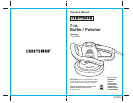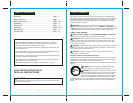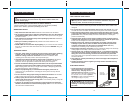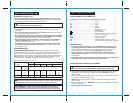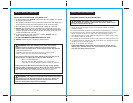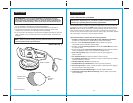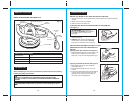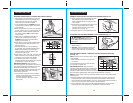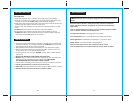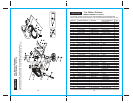
7
SAFETY INSTRUCTIONS cont.
SERVICE SAFETY
1. If any part of this tool is missing or should break, bend, or fail in any way;
or should any electrical component fail to perform properly: SHUT OFF the
power switch and remove the tool’s plug from the power source and have the
missing, damaged or failed parts replaced BEFORE resuming operation.
2. Have your power tool serviced by a qualified repair person using only
identical replacement parts. This will ensure that the safety of the power tool
is maintained.
3. If the replacement of the supply cord is necessary, this has to be done by the
manufacturer or his agent in order to avoid a safety hazard.
SAFETY RULES FOR BUFFER / POLISHERS
1. Read, understand and follow all safety rules and user instructions in this manual
and all directions and warnings on polishes and waxes BEFORE using this
buffer / polisher.
2. Vehicle should be clean and dry before using your buffer polisher. Remove all road
tar, excess grease spots and bug stains.
3. ALWAYS make sure the vehicle’s surface is cool before washing and using the
buffer / polisher.
4. When changing accessories, BE SURE that the switch is in the OFF position and
the cord is unplugged.
5. DO NOT apply wax directly on car.
SAFETY SYMBOLS FOR YOUR TOOL
WARNING:
USE OF ACCESSORIES THAT ARE NOT RECOMMENDED
FOR USE WITH THIS TOOL MAY CREATE A HAZARDOUS CONDITION.
!
V.......................................................................Volts
A......................................................................Amps
Hz....................................................................Hertz
W.....................................................................Watts
min..................................................................Minutes
....................................................................Alternating current
..................................................................Direct current
n
o
....................................................................No-load speed
....................................................................Class II construction, Double Insulated
RPM………………………............................. . .Revolutions per minute
SPM…...........................…………………….....Strokes per minute
OPM………………..........................………..... Orbits per minute
....................................................................Indicates danger, warning or caution.
It means attention! Your safety is involved.
The label on your tool may include the following symbols.
!
6
SAFETY INSTRUCTIONS cont.
WARNING:
Check extension cords before each use. If damaged
replace immediately. Never use tool with a damaged cord since touching
the damaged area could cause electrical shock, resulting in serious injury.
!
2. Power tool plugs must match the outlet. Never modify the plug in any way.
Do not use any adapter plugs with grounded power tools. Unmodified plugs
and matching outlets will reduce risk of electric shock.
3. Avoid body contact with grounded surfaces such as pipes, radiators, ranges
and refrigerators. There is an increased risk of electric shock if your body is
grounded.
4. Do not expose power tools to rain or wet conditions. Water entering a power
tool will increase the risk of electric shock.
5. Do not abuse the cord. Never use the cord for carrying, pulling or unplugging
the power tool. Keep cord away from heat, oil, sharp edges or moving parts.
Damaged or entangled cords increase the risk of electric shock.
6. When operating a power tool outdoors, use an extension cord suitable for
outdoor use marked “W-A” or “W”. Use of a cord suitable for outdoor use
reduces the risk of electric shock.
7. If operating a power tool in a damp location is unavoidable, use a Ground
Fault Circuit Interupter (GFCI) protected supply. Use of a GFCI reduces the
risk of electric shock.
ELECTRICAL SAFETY cont.
EXTENSION CORDS
USE PROPER EXTENSION CORD. Make sure your extension cord is in good
condition. When using an extension cord, be sure to use one heavy enough to carry
the current your product will draw. An undersized cord will cause a drop in line
voltage resulting in loss of power and overheating. Table 1 shows the correct size to
use depending on cord length and nameplate ampere rating. If in doubt, use the
next heavier gage. The smaller the gage number, the heavier the cord.
Table 1: Minimum Gage for Cord
!
CAUTION:
Keep the extension cord clear of the working area.
Position the cord so that it will not get caught on lumber, tools, parts of the
vehicle or other obstructions while you are working with a power tool.
WARNING:
Double insulation DOES NOT take the place of normal
safety precautions when operating this tool.
!
Ampere
Rating Volts Total cord length (in feet)
More Than
0
6
10
12
6
10
12
16
18
18
16
14
16
16
16
12
Not recommended
16
14
14
14
12
12
Not More
Than
120V 25 50 100 150
AWG



